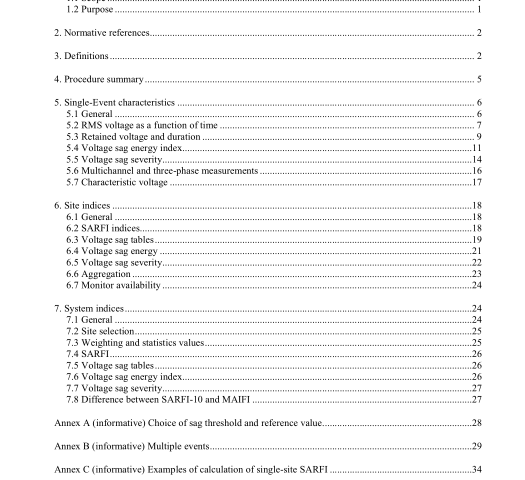IEEE 1564-2014 pdf download.IEEE Guide for Voltage Sag Indices
6. Site indices
6.1 General As input to the site indices, the single-event characteristics are used as obtained from all events recorded at a given site over a given period, typically one month or one year. The clauses that follow present a number of alternatives for the two-index method. Each alternative can be summarized as a count of events within a certain range of retained voltage and duration. For single-index methods, the site index is the sum of the single-event indices of all events recorded within the given period. When publishing site indices, it is important to indicate which method has been used to obtain the single- event characteristics: for example, the lowest of the three phase-to-ground voltages, the lowest of the three phase-to-phase voltages, or the characteristic voltage obtained from three-phase measurements.
6.2 SARFI indices
System Average RMS Variation Frequency Index (SARFI) is a power-quality index that provides a count or rate of voltage sags, swells, and/or interruptions for a system. The size of the system is scalable: it can be defined as a single monitoring location, a single customer service, a feeder, a substation, a group of substations, or an entire power delivery system. There are two types of SARFI indices: SARFI-X and SARFI-Curve. In this clause, SARFI is used as a single-site index (a one-site system). In the next clause, it is used as a system index. The index provides how many (annual) events there are when the magnitude of a voltage sag is below a specified threshold.
6.2.1 SARFI-X SARFI-X corresponds to a count or rate of voltage sags, interruptions, and/or swells below or above a specified voltage threshold. For example, SARFI-90 considers voltage sags and interruptions that are below 0.90 per unit, or 90% of the reference voltage. SARFI-70 considers voltage sags and interruptions that are below 0.70 per unit, or 70% of the reference voltage. SARFI-110 considers voltage swells that are above 1.1 per unit, or 110% of the reference voltage.
The SARFI-X indices are meant to assess short-duration rms variation events only, meaning that the only events included in its computation are those with durations less than the minimum duration of a sustained interruption as defined by IEEE Std 1159, which is 1 min.
6.2.2 SARFI-Curve
SARFI-Curve corresponds to a rate of voltage sags below an equipment compatibility curve. For example, SARFI-CBEMA considers voltage sags and interruptions that are below the lower Computer Business Equipment Manufacturers Association (CBEMA) curve (CBEMA is now the ITI). 8 SARFI-ITIC considers voltage sags and interruptions that are below the lower ITIC curve. SARFI-SEMI considers voltage sags and interruptions that are below the lower SEMI curve. Again, these curves limit the duration of an rms variation event to the minimum duration of a sustained interruption as defined by IEEE Std 1159, which is 1 min. 6.3 Voltage sag tables A commonly used method of presenting the performance of a site is by means of a voltage sag table. The columns of the tables represent ranges of voltage sag duration, while the rows represent ranges of retained voltage.
Each cell in the table gives the number of events with the corresponding range of retained voltage and duration. Each event (that is, each combination of retained voltage and duration) is tabulated in only one cell of the table. Different values are in use for the boundaries between the cells. Some possible table choices are presented in 6.3.1, 6.3.2, and 6.3.3. In each example, a maximum voltage sag duration of 1 min has been used, which is consistent with the minimum duration of a sustained interruption as defined by IEEE Std 1159. (Note that IEEE Std 1366 uses a minimum of 5 min for a sustained interruption instead, since the recommended practice has a reliability context. The context of IEEE Std 1159 is power quality.) In the example voltage sag tables below, the retained voltage is expressed in percent, but it may also be expressed in volts. The duration should be expressed in milliseconds, seconds or minutes, with the exception of the first column, for cases in which the maximum duration is one cycle.
A voltage sag table can be used as a system index as well as a site index. Strictly speaking, a voltage sag table is not an index but a way of presenting a set of indices. Each element in the table can be used as an index, just as there are multiple choices for the SARFI indices. A distinction between short-duration interruptions and other voltage sags is made already when defining the range of retained voltages. In cases in which short-duration interruptions are treated differently from other voltage sags, the lower row of the table should start at 1% or 10%.IEEE 1564 pdf dwonload.IEEE 1564-2014 pdf download
IEEE 1564-2014 pdf download

Leave a Reply